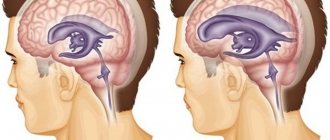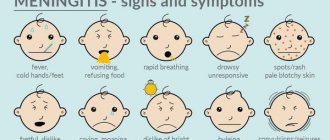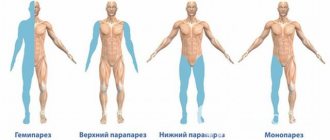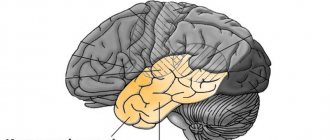What is the reason?
The corpus callosum is located exactly midway between the two hemispheres of the brain. Its functions were discovered relatively recently, around the 60-70s of the last century, and by accident. In the treatment of epileptic seizures, there was a practice of splitting the body into two halves, as a result of which the seizures disappeared, but many side effects appeared from such a procedure, which prompted the doctors who conducted the study to the right thoughts. The corpus callosum is a conductor of neurons between the two hemispheres; thanks to it, many important processes occur in our body, such as:
- physical activity;
- manifestations of feelings;
- cognitive processes.
The corpus callosum is highlighted in red.
It is impossible to say that all these processes will be limited for the patient; this is possible only in an extremely severe form of the disease, but the presence of deviations will be noticeable to the naked eye.
For example, when the corpus callosum was dissected in an adult with epileptic seizures, after some time it was noticed that everything related to creativity (drawing, poetry, etc.) could only be done with the left hand, while ordinary procedures (receiving food, rewriting text) only with the right hand.
What can we say about a person with hypoplasia of the corpus callosum? In this case, the consequences are much more severe, but... First things first.
The cause of this disease is not fully known, but scientists agree that the lion's share lies in genetic abnormalities that arise during intrauterine development, in particular, at 2–3 weeks of the embryonic period.
In addition, it is believed that the presence of hypoplasia is determined by mutations that affect brain development. Unfortunately, doctors are not able to give more accurate information.
Mothers who are at risk include:
- drink alcoholic beverages during pregnancy;
- suffered from rubella during pregnancy, just like toxoplasmosis or severe forms of influenza;
- were exposed to radiation;
- were subject to general intoxication of the body.
This disease is classified as rare and, according to statistics, occurs in every 10,000th baby.
Grodno Regional Children's Clinical Hospital
Details Published June 28, 2018
The corpus callosum is the commissural fibers of the brain that connect the right and left hemispheres of the cerebrum.
Agenesis (hypo-dysgenesis) refers to the absence of callosal adhesions connecting the cerebral hemispheres, both partially and completely.
The formation of the corpus callosum, septum pellucidum and fornix begins at 11 weeks of intrauterine life and ends by 16 weeks. Depending on this, the degree of the corpus callosum defect is related to the stage of fetal development.
Primary agenesis occurs before the 12th week of fetal life as a consequence of vascular or inflammatory damage, and can be isolated or associated with other malformations (for example: agenesis of the septum pellucidum, holoprosencephaly (a disorder of brain formation, which is characterized by a complete or partial absence of division into hemispheres, in combination with other developmental defects).
Secondary dysgenesis - partial or complete destruction of the corpus callosum - develops after the formation of the corpus callosum (traumatic, toxic injuries, anoxia in the anterior cerebral artery system).
Agenesis of the corpus callosum is more often found in children with hydrocephalus, also in combination with other brain malformations.
Disruption of the development of the corpus callosum does not have a characteristic clinical picture, and neurological symptoms are most often represented by nonspecific intellectual and neurological disorders, up to a completely asymptomatic course. When agenesis of the corpus callosum is combined with other malformations of the brain and skull, it is the manifestations of the latter that may come to the fore.
CT signs of agenesis of the corpus callosum: widely spaced anterior horns and bodies of the lateral ventricles, high standing of the third ventricle between them; the medial walls of the lateral ventricles acquire a parallel course, and their posterior horns are usually expanded (colpocephaly). MRI performed in 3 planes gives a complete picture of the degree of underdevelopment of the corpus callosum: partial - hypogenesis, complete - agenesis, or partial defect in its formation - dysgenesis. The most indicative are sagittal sections, which make it possible to differentiate the formation of all its sections. Agenesis (hypogenesis) of the corpus callosum is often combined with the absence or underdevelopment of the hippocampus, amygdala, gray matter heterotopia, or other brain malformations.
Ultrasound is used as the primary diagnostic method. Unfortunately, performing an echography procedure in the prenatal period has many difficulties, including due to the peculiarities of fetal presentation, which leads to an increase in cases of missing this pathology. And with dysgenesis, hypogenesis, it is even more difficult to detect a defect. What makes the interpretation of the disease difficult is that agenesis is often combined with multiple malformations and various genetic symptoms.
To obtain a complete picture of the examination, if an anomaly is suspected, it is necessary to perform karyotyping, as well as a thorough ultrasound analysis, the most informative is the use of magnetic resonance imaging. Thus, only a combination of modern diagnostic methods makes it possible to more reliably identify cases of impaired development of the corpus callosum.
MRI doctor Rusina T.P.
How to recognize?
Hypoplasia of the corpus callosum in a newborn is diagnosed, as a rule, after the first two months of life, but more often it occurs during fetal development.
If doctors looked at the disease before the birth of the child, then during the first 2 years of life the child will develop harmoniously, as befits a normal baby, and only after the specified time has passed, parents may notice some deviations, such as:
- infantile spasms;
- convulsions;
- epileptic seizures;
- weakening of the cry;
- impaired sense of touch, smell and vision;
- decreased communication skills;
- manifestations associated with muscle hypotension.
infantile spasms – convulsions characterized by sudden flexion and extension of the arms and legs
muscle hypotonia is a condition characterized by decreased muscle tone that can develop in combination with a decrease in muscle strength in the patient.
If in childhood, for some reason, it was not possible to diagnose and recognize the presence of the disease, it will certainly manifest itself in adulthood, symptoms include:
- impairment of visual or auditory memory;
- hypothermia;
- problems with movement coordination.
Hypothermia – problems with the body’s thermoregulation (decrease in body temperature below 35 degrees)
How and with what we treat
Basically, the course of treatment for this pathology is to minimize the manifestations of the disease and achieve the cessation of infantile spasms.
Therapeutic methods, according to experts, that are used in treatment do not bring the desired effectiveness. In addition, the technique has not been improved and not fully developed.
Mostly strong drugs are used, in maximum doses and courses. Such shortcomings are explained by completely objective reasons. Since the method of treating agenesis is in a constant search for new and improved methods of getting rid of this disease.
The disease itself is carefully studied, but tangible desired results are almost impossible to achieve, because it is very difficult to diagnose at the stage of development of the disease. All this is due to the position of the fetus, which does not allow a clear and visual examination of the cavities and structures of the brain.
Pathologies of the corpus callosum or its insufficient development in children, as a rule, affect the state of their neurological development. However, there are cases where, in the absence of any other anomalies, a normal karyotype was noted. The observation period in this case was quite long. Children were observed until they were 11 years old.
Among the forms of manifestation of agenesis, the most common cases are Aicardi syndrome. At the same time, about five hundred manifestations of this syndrome have been noted on the planet, the largest number in the land of the “rising sun” Japan.
In those who had a similar pathology, disorders associated with abnormal eye development were noted. One of these anomalies is retinitis pigmentosa, which is expressed in decreased visual acuity, cataracts, damage to the optic nerve and other pathologies.
How is diagnostics carried out in a hospital setting?
As a rule, a large number of concomitant diseases can develop with hypoplasia of the corpus callosum, so it is possible that there may be other symptoms (different from those mentioned above). In 80% of cases, the diagnosis of this disease occurs in fetal development using ultrasound diagnostics.
However, it is possible to prescribe additional tests after birth (if during pregnancy the clinical picture was not completely clear) or after the parents contact a specialist. The doctor conducts an initial survey and clarifies the presence of symptoms characteristic of this diagnosis, after which he usually prescribes:
- magnetic resonance therapy (MRI);
- head electroencephalogram (EEG);
- other neurological studies.
Based on the data obtained from the above-mentioned studies, the doctor makes a conclusion and prescribes treatment.
Features of treatment
Unfortunately, effective treatment has not yet been invented, and doctors mostly struggle with the symptoms of the disease, so children with this diagnosis are doomed to constant treatment and supportive care.
The specific plan is selected by the attending physician individually for each person. It all depends on the severity of the damage to the corpus callosum and the clinical picture of the disease.
In 70-75% of cases there is an unfavorable outcome. There is a high probability of mental retardation and the development of serious mental disorders such as schizophrenia, etc.
What conclusions should you draw:
- Diagnosis of fetal malformations is a responsible matter that does not tolerate haste and a superficial approach to research.
- in each trimester of pregnancy, new pathologies unique to this period of fetal development may be discovered. Don't miss screening deadlines
- The experience of a doctor-researcher + high-quality equipment is the key not only to timely diagnosis of fetal malformations, including agenesis of the corpus callosum, but also the key to a rational choice of further obstetric tactics.
Tips for parents
If your baby has been diagnosed with hypoplasia of the corpus callosum in a newborn, then your support and help will be important to him. Here are some general recommendations for providing preventive actions for your baby at home:
- Pay attention to the general condition of the baby; if he is tired or does not show interest in activities or communication, give him time to rest, he himself will let you know when you can resume the procedure.
- Carry your baby in the “airplane” position, this exercise has a strengthening effect on the body, the main thing is not to overdo it.
- Lay your baby on your chest, face to face, so that his arms are under your breasts, stroke him with your hand from head to butt - this procedure will help him transfer weight from his head to his pelvis, you can also put him on the bed, and fold him under his stomach roll from a towel.
- If your baby makes sounds, copy them and repeat after him, with the same intonation, try to maintain short pauses, this will encourage him to repeat.
- When playing with a rattle, let your child fixate his gaze on it and slowly move it from side to side, encouraging him to follow the toy. If you lose sight of her, lightly rattle her to attract her attention and continue the procedure. If the child has lost interest, do not press him, give him a break.
Unfortunately, the diagnosis of hypoplasia is serious and often does not come alone, we can only wish patience to parents with sick children, but you yourself should hope for the best, since 25-30% have a positive result, and perhaps you will be one of these percentages .











